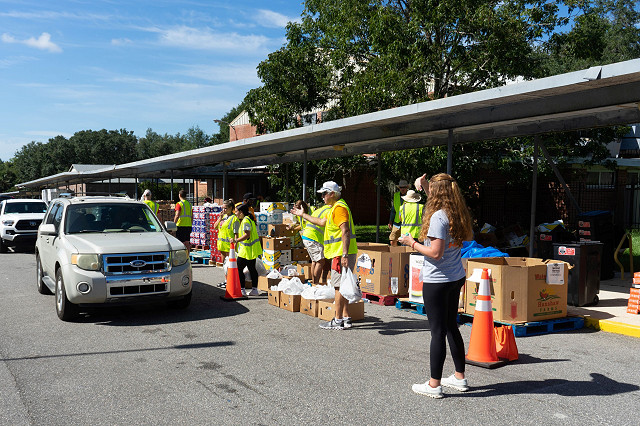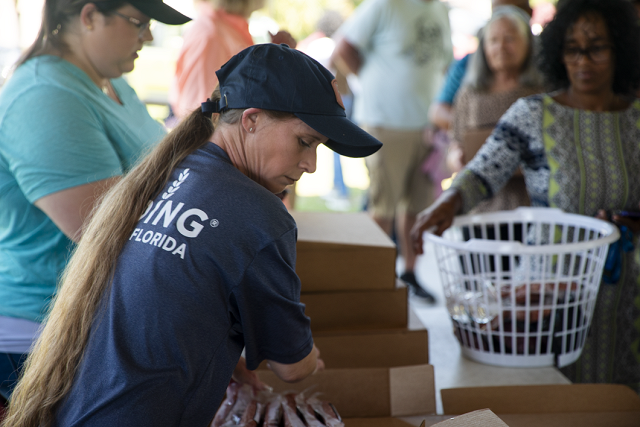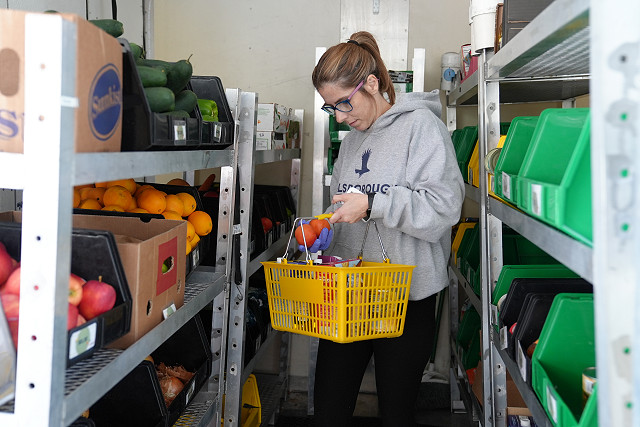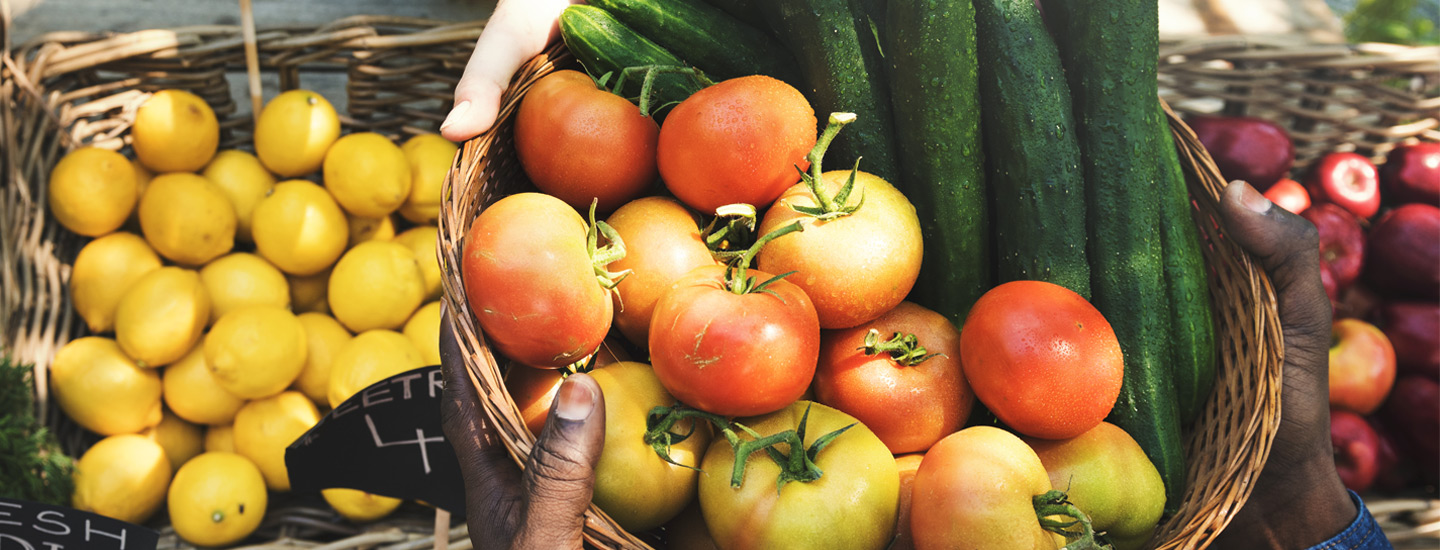Distributions: Moving Food From the Food Bank to the Home
If food banks provide the strong roots that ground our network, our partner food pantries are the wide-reaching branches that stretch into communities across the state, offering shade, support, and fresh possibilities. But sometimes our food banks have to go further and distribute food directly or further support larger pantries when the need arises.
Because our food banks are dedicated to making sure every neighbor across the state has access to healthy food, they use a variety of distribution models designed to reach people wherever they are. This may look different if it’s a scheduled pantry distribution, a holiday effort, or during emergencies. But blue skies or grey, Feeding Florida’s food banks are moving food into communities and into the homes of the people who need it most.
Emergency Distributions
 When disaster strikes, Feeding Florida is ready. Our food banks strategically stage resources statewide, with over 20 warehouses, more than 160 trucks, and over 500,000 square feet of storage. This allows us to take emergency distributions in three phases.
When disaster strikes, Feeding Florida is ready. Our food banks strategically stage resources statewide, with over 20 warehouses, more than 160 trucks, and over 500,000 square feet of storage. This allows us to take emergency distributions in three phases.
- Immediately after a storm, we are able to be the first to set up outdoor distributions of MREs and water. What you see in photos is boxes upon boxes of emergency food and cases of water. We also provide these resources to shelters holding evacuees. We meet the immediate need of a meal and water until hot meal services and other resources make it to disaster areas to provide support.
- If an area is without power, like we saw after Hurricane Ian or Hurricane Idalia, the next phase is providing food boxes filled with non-perishable items and hand-held fruit that doesn’t need refrigeration.
- When there is power and refrigeration available, but with limited resources and in “relief mode”, our food banks can offer more diverse food boxes or selections, in addition to dry goods like pastas and bread, to help replenish the food that went bad after the storm– like fruits, vegetables, dairy, meats, and other refrigerated items that are critical for a family’s nutrition.
For most disaster response distributions, because there is a need to move quickly and we don’t want to inconvenience folks more than a storm already has, these tend to be drive-up distributions. Items are boxed up and folks pop their trucks for volunteers to put the food directly into vehicles. If there is safe, nearby parking available and enough variety to offer selection, walk-up distributions may occur around phase 3 so that neighbors can select what’s best for their families and their circumstances (whether they have power, refrigeration, or appliances post-storm). In some cases, people are still removing trees from their houses or dealing with damaged cars from the storm, so an individual may be picking up food for their family in addition to other families and neighbors. Our food banks work diligently to ask the appropriate questions to make sure everyone in the community gets the food and resources they need.
These preparations, combined with the ability of our food banks and national partners, allow us to respond quickly and effectively when every minute counts.
Drive-Up Distributions
 At drive-up pantries, neighbors arrive at a predetermined location, often a church, school, or community parking lot, where volunteers greet them and guide them through a quick check-in. Families share a few basic details, like household size or zip code, which helps organizers understand community needs and decide where additional support or new sites may be needed. It’s a simple step, but it keeps the distribution organized and ensures food is reaching the right places.
At drive-up pantries, neighbors arrive at a predetermined location, often a church, school, or community parking lot, where volunteers greet them and guide them through a quick check-in. Families share a few basic details, like household size or zip code, which helps organizers understand community needs and decide where additional support or new sites may be needed. It’s a simple step, but it keeps the distribution organized and ensures food is reaching the right places.
Neighbors drive through slowly, trunks and doors open, as volunteers load food into their cars. Even at a fast pace, volunteers make an effort to connect, and these moments often become surprisingly meaningful. Check-in teams get to know families over time—waving to familiar faces, asking how things are going, and noticing changes in their situations. Many volunteers say these small interactions turn a routine task into genuine relationship-building. Staff also welcome new faces or walk alongside cars to share information, though there’s little time for long conversations without slowing the line. Most neighbors have already waited hours before the official start, and with so many people in need, the drive-thru model remains the most efficient way to serve large numbers.
Second Harvest of the Big Bend recently created an intervention at some of their drive-thrus that lets neighbors tune into a specific radio station to hear pre-recorded Nutrition Education classes while they wait. It’s a clever solution to the long-standing challenge of reaching drive-thru sites with more impactful information.
The food boxes families receive are thoughtfully assembled to provide a variety of nutritious options. They often include fresh fruits and vegetables, bakery items, pantry staples like peanut butter or canned goods, and frozen proteins when available. Occasionally, distributions may include essentials such as feminine hygiene products or other household items. These boxes are designed not just to meet immediate needs, but to help families prepare healthy, balanced meals at home.
This model is highly adaptable. Drive-up pantries can run almost anywhere, from paved lots to rural open spaces, making it easy to bring food directly into the communities that need it most. Even though the setup looks simple, it’s built on efficiency, with client dignity and a strong sense of connection in mind.
Walk-Up Distributions
 At most distributions, no matter the format, staff and volunteers are working hard. Product often arrives the same day, sometimes minutes before distribution. Volunteers must move quickly, lifting heavy packages and setting up tables so everything runs as smoothly as possible. For volunteers, walk-up pantries offer a unique way to engage with their neighbors. There’s time to answer questions, notice patterns of need, and build relationships with people over repeated visits. For food banks, the direct interaction provides valuable insight about who is being served and where additional support might be helpful.
At most distributions, no matter the format, staff and volunteers are working hard. Product often arrives the same day, sometimes minutes before distribution. Volunteers must move quickly, lifting heavy packages and setting up tables so everything runs as smoothly as possible. For volunteers, walk-up pantries offer a unique way to engage with their neighbors. There’s time to answer questions, notice patterns of need, and build relationships with people over repeated visits. For food banks, the direct interaction provides valuable insight about who is being served and where additional support might be helpful.
Walk-up pantries let neighbors pick up food on foot at locations hosted by community partners. Some drive-thrus even allow walkers to move through before the cars. They move station to station, though they usually receive slightly less food since they can carry only so much. However, this allows for client choice, so that individuals and families can pick the food they know they need or can specifically meet their family’s needs. Neighbors will often use bikes, backpacks, shopping carts, strollers, or even luggage to transport what they can. In addition to pre-packed groceries, some walk-up distributions allow families to enjoy hot meals or ready-to-eat foods on site.
Walk-up pantries are especially well-suited for neighborhoods where parking is limited, streets are busy, or families live in dense areas where it’s easier to walk than drive. They also encourage social connection—neighbors often meet others in their area, volunteers can share helpful tips, and families feel more seen and supported. Everyone is welcome at these events, regardless of where they live or work, which helps ensure that assistance reaches as many people as possible.
Choice Pantries (Grocery Store Model)
Choice pantries give neighbors the experience of shopping for their own groceries, much like walking into a grocery store. Partial-choice models let guests select from a few options—often produce or large-quantity items—with help from volunteers or signage.
Full-choice pantries go further, set up like small grocery stores where families shop independently with carts and staggered 30-minute time slots to prevent overcrowding. This approach allows neighbors to choose the produce their kids will actually eat; pick their favorite grains, proteins, or snacks; and select items that work best for their household. Volunteers may walk alongside guests to offer guidance, provide nutrition advice, answer questions, or help navigate the space, but the decisions always remain with the families. This model supports dignity, choice, and empowerment, giving neighbors control over their food while respecting their health needs, cultural traditions, and personal tastes. Families often leave feeling like they’ve shopped at a real grocery store, proud and supported while receiving nutritious food.
Other choice pantries operate on an “open hours” model with minimal staff or volunteers. These sites usually offer shelf-stable items without refrigeration or regular restocking and are often found on college campuses, in churches, or at resource centers. Some require referrals, while others operate freely. Visitors typically sign in and can access printed resources, though volunteers have less opportunity to connect. For some neighbors, especially those who prefer privacy, this model feels safer and more comfortable.
Mobile Food Pantries
 Mobile pantries bring food directly to neighborhoods and rural areas, often in partnership with local churches, community groups, or affordable housing sites. Imagine a box truck or food truck that’s been converted to become a mobile grocery store.
Mobile pantries bring food directly to neighborhoods and rural areas, often in partnership with local churches, community groups, or affordable housing sites. Imagine a box truck or food truck that’s been converted to become a mobile grocery store.
Some mobile pantries are semi-delivery, going to a location where neighbors can pick it up during set times. These drop-offs may be staffed by the site or run independently, depending on capacity. Other mobile distributions operate more like walk-up pantries with a “pop-up style” at pre-determined public locations. A food bank truck brings food, tables, signage, and staff, sets up, runs the distribution, then tears everything down before heading to the next site. These events create opportunities for volunteers and neighbors to connect, chat, and build community. They often focus on food deserts or areas with limited access to nutritious food.
Some mobile pantries take it a step further with refrigerated trucks, allowing neighbors to shop on board, either full-choice, partial-choice, or menu-select items. These mobile units remove barriers, expand access, and create a friendly, farmers market–style atmosphere.
Many also foster lasting partnerships with local organizations, health care partners, universities, and government agencies. Some food banks have even branded their trucks: Feeding the Gulf Coast has “Millie,” Feeding Tampa Bay runs “Groceries on the Go,” and Feeding South Florida delivers with its “‘Farm’acy.”
Partner Agencies & Other Models
Community partners are the heart of Feeding Florida’s network. Local smaller, nonprofits, churches, schools, and universities take food from our network and distribute it through scheduled appointments, their local pantries, or other programs. This lets partners meet their neighbors’ needs while keeping services dignified and accessible.
Many of these programs start small—a holiday meal or a single food drive—and grow into year-round resources. Together, these partners form a statewide network, reaching deep into communities and ensuring families have safe, nutritious food all year long.
From emergency relief to everyday programs, Feeding Florida’s network of food banks uses a variety of distribution models to reach people in every corner of the state. Each model, whether drive-up, mobile, or partner-led, plays a critical role in getting food for the people who need it most.
Hunger is too big for any one organization to solve alone. Learn how you can support, volunteer, or partner with Feeding Florida’s food banks and help us build a stronger, healthier Florida—one neighbor at a time.


